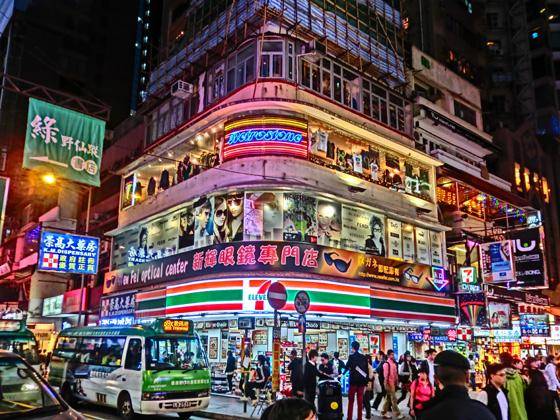Table of Contents
The birth and transformation of a modern landmark
Completed in 1957, Champagne House was once one of the tallest buildings on the Kowloon Peninsula, symbolizing the prosperity of Hong Kong's post-war economic takeoff. Its design combines modernist style, and its glass curtain walls and streamlined structure were considered avant-garde at the time. In the 1960s, the basement and lower-level shopping malls of the building gradually became a holy place for Hong Kong photography enthusiasts, gathering dozens of camera and photographic equipment stores, attracting local professionals and overseas tourists, and establishing its status as the "Kingdom of Photographic Equipment". However, with the transformation of Hong Kong's industrial structure and changes in the real estate market, the fate of Champagne House underwent a dramatic change in the 1990s.
Subdivided housing economy and the rise of the sex industry
In the 1990s, Hong Kong's property prices soared and the grassroots housing shortage problem worsened, and the "subdivided flat" model came into being. In response to falling rental income, the owners of Champagne Buildings have divided the units into smaller spaces for rent. This move unexpectedly attracted sex workers to move in, with Block B in particular becoming a concentration of prostitutes. In the early days, it was mainly based on "one prostitute per floor" in the local area, with sex workers operating independently, forming a semi-hidden gray area. After 2000, with the frequent exchanges between the mainland and Hong Kong, the gangs saw the business opportunities and controlled the industry chain in a "one-stop" mode: from recruiting mainland women to Hong Kong, forging documents, renting subdivided flats, to recruiting customers through pornographic websites and dating apps, gradually monopolizing the pornographic market in Champagne Building. During the peak period, nearly 200 subdivided flats in the building were converted into prostitution brothels, with an average monthly "sexual money" income of more than HK$5 million, becoming an important source of income for the gang.

Time Economics:
Taking advantage of the white-collar workers' habit of "taking a break" during lunch time, they created a "lunch peak". There was once a strange scene of 80 clients queuing up at the same time, reflecting their precise market strategy. However, behind the prosperity, crimes are frequent: sex workers being exploited, clients being blackmailed, gang fights and other incidents are frequently reported in the news, and the security in the building is rapidly deteriorating.
Political Scandals and Social Controversies
In July 2011, former Democratic Party Kowloon City Council vice-chairman Chan Ka-wai was revealed to have patronized Champagne House, exposing Champagne House’s “political and business patronage chain.” Chen initially argued that he was "conducting a social survey," but eventually resigned from the party due to pressure from public opinion. This incident has aroused public doubts about the ethical conduct of public officials and also reflects the complex entanglement between the pornography industry and the social power structure. The controversy focused on two aspects:
- Moral criticism: Moralists condemned the building as a "moral black hole" and demanded that the government step up its crackdown;
- Economic reality: Social welfare groups point out that most prostitutes working in subdivided flats are from economically disadvantaged groups, and the crackdown on prostitution may exacerbate their survival difficulties.
Police 'uprooting' and the end of an era
In the 2010s, the developer launched the Champagne Tower acquisition plan and by 2023 had acquired ownership of more than 75%. The gangs took advantage of the increase in vacant units to break into the houses and build subdivided flats, which eventually led to a strong counterattack by the police. In 2023, the police launched an inter-departmental operation codenamed "Beacon Fire", mobilizing hundreds of police officers to conduct surprise searches, seizing a large number of surveillance equipment and transaction records, and clearing out all 149 occupied subdivided flats. After the operation, the windows of the building were sealed, the Fenglou sign was removed, and the corridors that once flashed neon lights were now in ruins.

The rise and fall of Champagne House reflects the social changes in Hong Kong over the past half century:
- Economic level: From the golden age of photography, the abnormal development of subdivided housing economy, to the acquisition and reconstruction of real estate capital, we witnessed the industry iteration and space competition;
- Cultural level: Its "dual nature" - a nostalgic landmark for camera fans during the day and a labyrinth of desire at night - has become a microcosm of Hong Kong's urban legend;
- Policy level: The tug-of-war between the effectiveness of anti-prostitution crackdowns and the problem of subdivided flats reflects the long-term dilemma of governing the grey area.
Today, Champagne House is awaiting reconstruction, but its history as an "Oriental erotic landmark" has long been embedded in Hong Kong's collective memory. If it is transformed into a luxury house or a shopping mall in the future, this past of "two hundred prostitutes on one floor" may become an unspeakable secret in urban archaeology.
Further reading:




